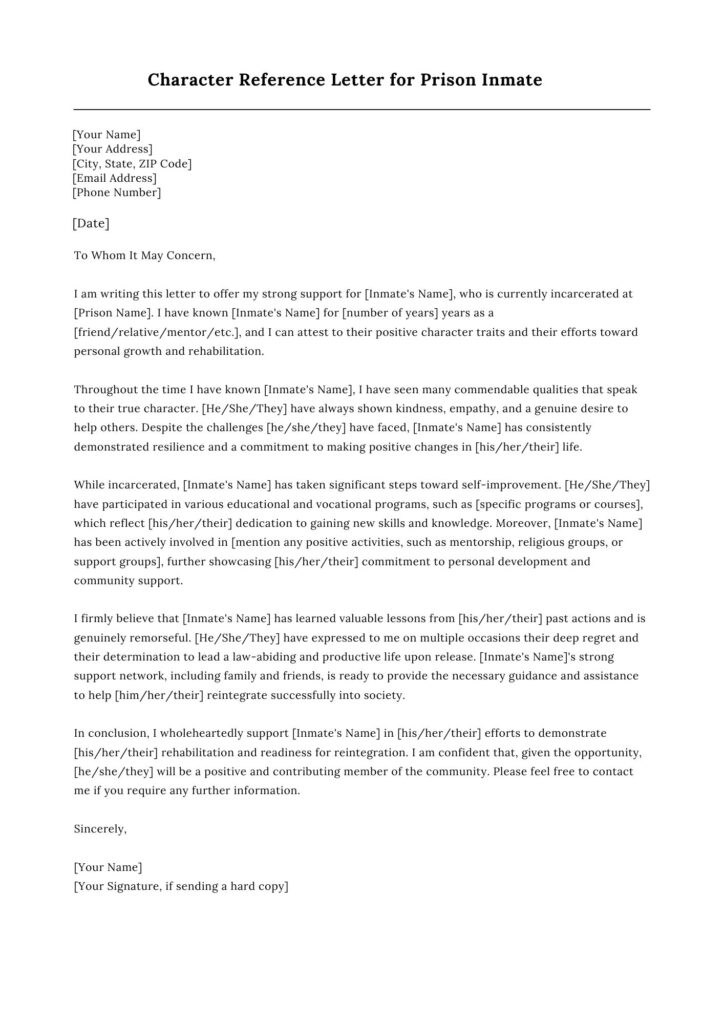A Character Reference Letter for a Prison Inmate serves as a valuable document that can influence decisions related to parole, sentencing, or other legal matters.
Sample Character Reference Letter for Prison Inmate Template
Let’s explore its purpose and significance of Character Reference Letter for Prison Inmate:
Parole Consideration:
- When an inmate becomes eligible for parole, they may request character reference letters to support their case. These letters provide insights into the inmate’s character, behavior, and potential for rehabilitation.
- The parole board reviews these letters to assess whether the inmate has demonstrated personal growth, remorse, and a commitment to positive change during their incarceration.
Positive Impression on the Judge or Parole Board:
- Judges and parole board members consider character reference letters during sentencing or parole hearings.
- A well-written letter can create a positive impression by highlighting the inmate’s good character, efforts toward self-improvement, and readiness to reintegrate into society.
Components of a Character Reference Letter:
- Introduction: Begin by stating how long you’ve known the inmate and your relationship with them.
- Specific Details: Describe the inmate’s positive qualities, such as honesty, responsibility, and empathy. Share examples of their behavior or actions that demonstrate growth.
- Trustworthiness: Express your trust in the inmate’s ability to reintegrate successfully.
- Closing Statement: Conclude with a positive overall assessment, emphasizing their potential for rehabilitation and a second chance.
Addressing the Letter:
- Address the letter to a specific individual if possible (e.g., the chairperson or director of the parole board).
- If unsure, use a general salutation like “To whom it may concern.”
- Format the letter professionally, including your address, the recipient’s address, and a handwritten signature.
Character Letter for Early Release From Prison
A character letter for early release from prison plays a crucial role in influencing the parole board or judge by providing a personal and positive perspective on the incarcerated individual’s character and behavior. These letters, typically written by family members, friends, employers, or community leaders, aim to present the inmate as a rehabilitated and responsible person who is ready to reintegrate into society.
The content of such a letter should include specific examples of the inmate’s positive attributes, efforts at self-improvement, and the support system they have outside of prison. This might involve highlighting their participation in educational programs, vocational training, or community service while incarcerated, and their commitment to leading a law-abiding life upon release.
Additionally, the letter should underscore the support network that awaits them, such as family members willing to provide housing or employment opportunities that ensure stability. The objective is to humanize the inmate, showing genuine remorse for past actions and a clear plan for a constructive future, thereby helping to convince the authorities that the individual is ready for a second chance.
How to write Character Refernce Letter for Early Release From Prison
Writing a character reference letter for early release from prison is a serious and sensitive task. It requires a heartfelt yet professional tone, focusing on the inmate’s positive qualities, rehabilitation efforts, and the support they will receive upon release. Here are detailed tips for crafting an effective and touching character reference letter:
Use a Professional Format
Start with your contact information, date, and the recipient’s information.
Example:
[Your Name]
[Your Address]
[City, State, ZIP Code]
[Email Address]
[Phone Number]
[Date]
[Recipient’s Name]
[Recipient’s Title]
[Parole Board or Judge’s Name]
[Institution’s Name]
[Institution’s Address]
[City, State, ZIP Code]
Greet the Recipient
Use a formal greeting, addressing the letter to the specific person or body handling the case.
Example:
Dear [Recipient’s Name],
Introduce Yourself
Briefly introduce yourself, stating your name, occupation, and your relationship to the inmate. Mention how long you have known the inmate and in what capacity.
Example:
My name is John Doe, and I am a social worker at XYZ Community Center. I have known Jane Smith for over ten years as a close family friend and through her involvement in community outreach programs.
State the Purpose of the Letter
Clearly mention that you are writing to provide a character reference for the inmate and support their early release.
Example:
I am writing to provide a character reference for Jane Smith, who is currently incarcerated at [Prison Name], and to support her petition for early release.
Detail the Inmate’s Positive Attributes
Describe the inmate’s positive qualities and behaviors, focusing on those that show their rehabilitation and readiness to reintegrate into society.
Example:
Jane is a compassionate and resilient individual who has always demonstrated a strong moral character. Throughout her incarceration, she has shown remarkable growth and commitment to bettering herself. Jane has participated in numerous educational programs, earning certifications in vocational skills and completing courses in anger management and personal development.
Provide Specific Examples
Include specific anecdotes or instances that illustrate the inmate’s positive changes, efforts, and behaviors while in prison.
Example:
During her time in prison, Jane took the initiative to lead a peer support group for other inmates, offering guidance and encouragement to those struggling with their circumstances. She also volunteered for the prison’s literacy program, helping fellow inmates improve their reading and writing skills. These actions reflect her dedication to making a positive impact, even in difficult circumstances.
Highlight the Support System
Emphasize the support the inmate will receive upon release, including family, friends, employment opportunities, and community resources.
Example:
Jane has a strong support network awaiting her upon release. Her family is fully prepared to provide her with a stable home environment, and I have personally arranged for her to join our community center’s employment assistance program. Additionally, she has secured a job offer from a local business that values her newly acquired skills.
Express Genuine Remorse and Commitment
Convey the inmate’s remorse for past actions and their commitment to leading a law-abiding and productive life upon release.
Example:
Jane deeply regrets her past actions and has consistently expressed genuine remorse. She understands the impact of her mistakes and is determined to make amends by contributing positively to society. Her time in prison has been a period of significant reflection and growth, and she is committed to utilizing her experiences to help others and avoid repeating her past mistakes.
Conclude with a Strong Endorsement
Summarize your support for the inmate’s early release, expressing confidence in their readiness to reintegrate and contribute to the community.
Example:
In conclusion, I wholeheartedly support Jane Smith’s request for early release. Her transformation and dedication to personal growth are evident, and I am confident that she will be a responsible, productive, and positive member of our community. I respectfully ask that you consider her petition and grant her the opportunity to demonstrate the progress she has made.
Offer to Provide Further Information
Let the recipient know that you are available for any further questions or information.
Example:
Please feel free to contact me at (555) 555-5555 or johndoe@email.com if you require any additional information or have any questions. I am more than willing to provide further details to support Jane’s case.
Close with a Professional Sign-off
Use a formal closing phrase and sign the letter.
Example:
Sincerely,
John Doe
Remember that character reference letters play a crucial role in advocating for an inmate’s release or reduced sentence. Honesty and sincerity are essential, as misleading information can harm the inmate’s chances.

I am Karisa E. Yocham, an Attorney at the California Department of Insurance. I earned my Juris Doctor from the University of California, Irvine School of Law and completed my undergraduate studies at the University of California, Davis. As a full-time attorney, I am dedicated to justice and consumer protection. Through CharacterReference.org, I share my expertise and insights to help others navigate legal challenges. My commitment to excellence and public service drives my work both in my career and online.


